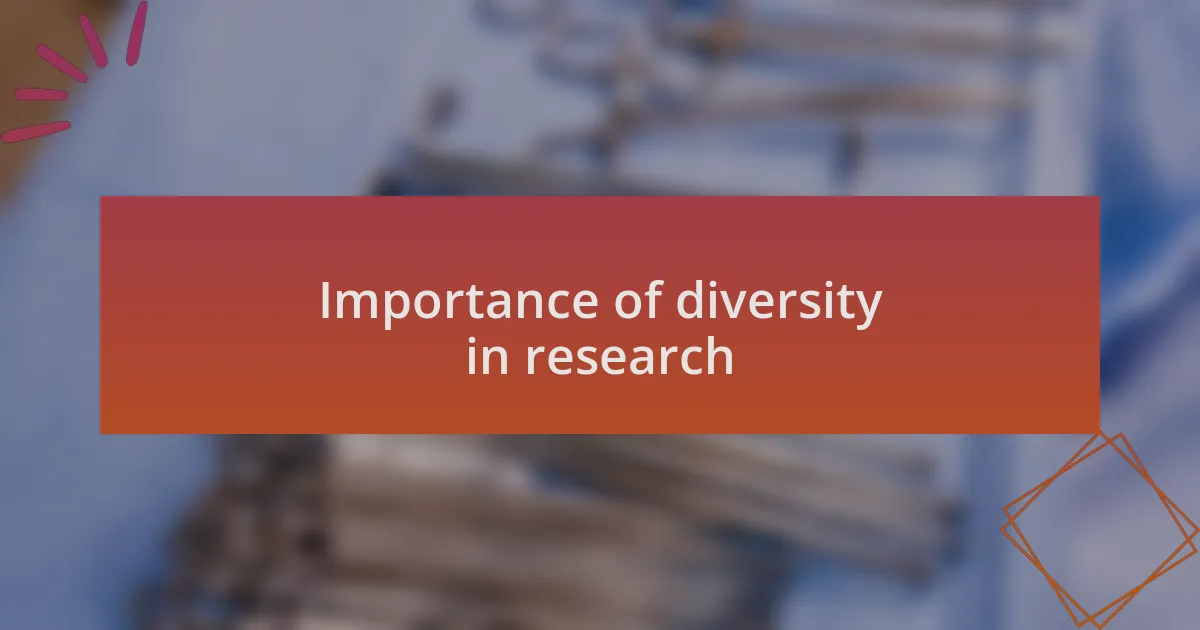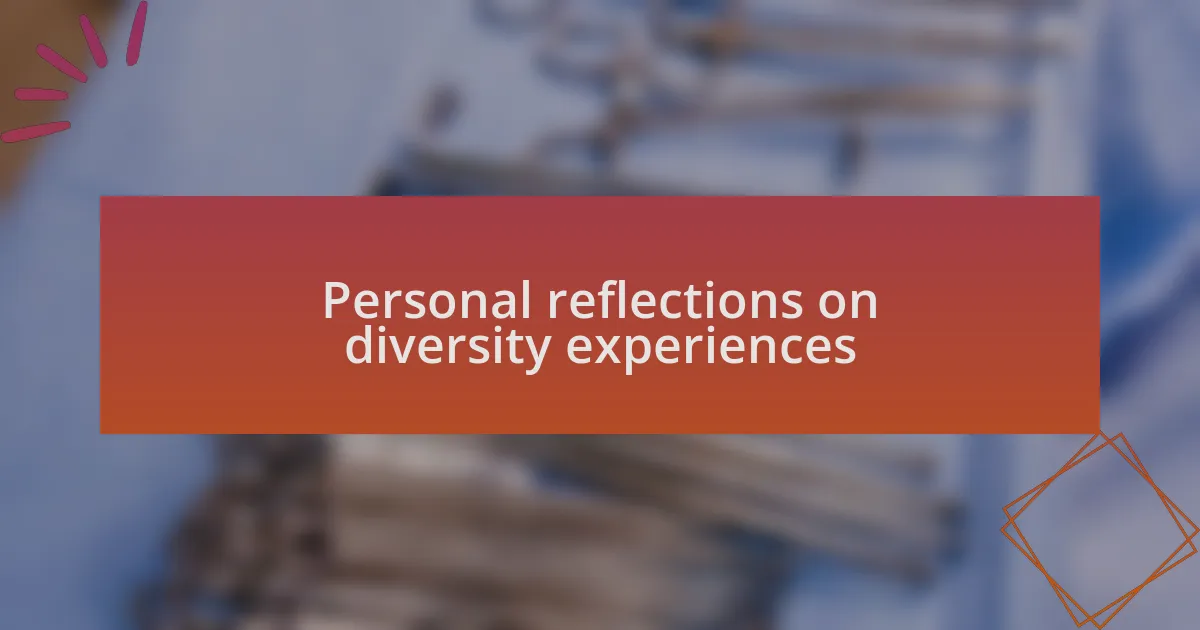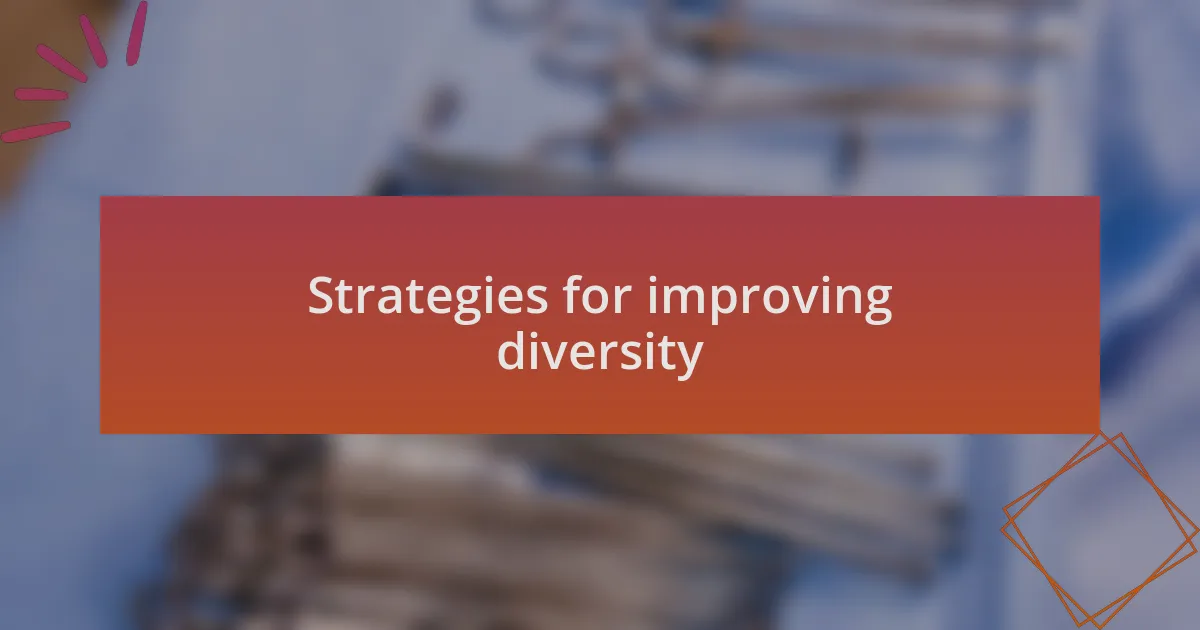Key takeaways:
- Diversity in clinical trials is crucial for accurate treatment responses and tailored healthcare, highlighting the need for varied representation in research.
- Systemic barriers, such as mistrust and socioeconomic factors, hinder diverse recruitment in trials, requiring researchers to build genuine community connections.
- Encouraging community engagement and incorporating diverse voices in study design can enhance participation and lead to more inclusive and effective research outcomes.
- Training on implicit bias can transform research environments, fostering inclusivity and improving the quality of findings.

Understanding diversity in trials
Diversity in clinical trials is not merely a checkbox; it’s essential for capturing the full spectrum of human response to treatments. I remember a particular study I read about that highlighted how results differed significantly across ethnic backgrounds. What if the next breakthrough treatment is skewed by a lack of representation? That possibility keeps me up at night, knowing how skewed data can misinform practice.
When I think about diversity, I often reflect on my experience working with patients from varying backgrounds. Each individual brings a unique story and a distinct perspective on health, influencing how they respond to medical interventions. This rich tapestry of experiences is invaluable; it’s more than just statistical representation; it’s about understanding a person’s narratives, their fears, and hopes surrounding treatment. Can we afford to overlook such a vital component in our quest for effective therapies?
Furthermore, it becomes clear that without diversity, our understanding of diseases and their treatment can remain incomplete. I once encountered a situation where a trial predominantly featured one demographic, ultimately leading to recommendations that didn’t resonate with broader populations. It made me wonder—how can we truly innovate in medicine if we ignore the voices that matter? Emphasizing diversity isn’t just ethical; it’s essential for advancing effective, tailored healthcare for everyone.

Importance of diversity in research
Diversity in research is crucial because it ensures that findings are applicable to a wider range of people. I recall a project where we had a diverse team analyzing data, and the different viewpoints led to unexpected insights that significantly improved our conclusions. How often do we hear about treatment plans that fail because they weren’t tested on the populations that need them most?
Another important aspect is representation in decision-making. I once watched a trial meeting where demographics were discussed, and it was disheartening to see a lack of varied voices. It made me wonder, if the people discussing the data don’t reflect the populations affected by it, can we trust their recommendations? It’s a sobering thought that genuine innovation relies on inclusive dialogue.
Moreover, diversity enriches the research process itself. In my experience, working alongside colleagues from different cultural backgrounds has opened my eyes to myriad perspectives on patient care. Each conversation has taught me something new about compassion and understanding, which ultimately leads to more holistic and effective research outcomes. Aren’t we all striving for a future where healthcare decisions resonate with everyone?

Challenges in achieving trial diversity
Achieving diversity in clinical trials is often hindered by systemic barriers. For instance, I remember discussing recruitment strategies with a colleague who highlighted the underlying mistrust some communities feel toward the medical establishment. This reluctance is deeply rooted in historical injustices and can lead to significant challenges in enrolling diverse participants, making it crucial for researchers to build genuine connections with these communities.
Another issue is socioeconomic factors that limit access to trials. I once met a patient eager to participate in groundbreaking research but faced challenges like transportation and time off work. It struck me how simple logistical hurdles can prevent potential participants from being involved, ultimately skewing the outcomes of the research. Isn’t it disheartening to think that innovative treatments may be developed without input from the very individuals who could benefit the most?
Additionally, addressing unconscious biases among researchers can be a significant challenge. During a recent conference on surgical research, I encountered a conversation that revealed just how prevalent these biases still are, even among well-meaning professionals. It made me reflect on how essential it is for our academic environment to actively confront these biases to promote trial diversity effectively. How can we hope to improve our research methodologies if we fail to recognize the complete spectrum of human experience?

Personal reflections on diversity experiences
Reflecting on my experiences with diversity in clinical trials, I recall attending a local health fair where I spoke with individuals from underrepresented communities. Many of them expressed their desire to participate in research but felt a disconnect with the processes. It made me question: how can we bridge this gap? The relationships built at such grassroots levels can profoundly influence trial enrollment and participation, reminding me that trust isn’t just given; it must be earned.
Another time, I facilitated a workshop aimed at training researchers on culturally sensitive practices. A passionate participant shared a story about a family member who was excluded from a trial due to language barriers. Hearing their frustration was a stark reminder that diversity isn’t just about numbers; it’s about creating inclusive environments where all voices can be heard. How often do we overlook the importance of language and communication in fostering diversity?
In my ongoing journey, I’ve also grappled with my biases when evaluating applicants for research roles. I recall a moment of realization when I dismissed a candidate simply based on their unconventional background. In retrospect, I understood that diversity brings fresh perspectives, and these perspectives are vital for the depth of our research. Isn’t it time we recognize that our traditional metrics may be limiting the rich tapestry of insights we desperately need?

Strategies for improving diversity
When considering strategies for improving diversity in clinical trials, I think about the critical role of community engagement. During my tenure with a research team, I collaborated with local organizations that focused on underserved populations. By hosting information sessions tailored to these communities, we were able to demystify the trial process, creating an open dialogue that led to increased interest and participation. Have we really tapped into the full potential of grassroots initiatives?
Another effective approach is to incorporate diverse voices in the design of our studies. I once worked on a trial that included an advisory board of community stakeholders, reflecting the demographics we aimed to engage. Their insights were invaluable in shaping our recruitment strategies and ensuring that our methodologies were culturally considerate. It made me wonder: how often do we overlook the benefits of involving those who know their communities best?
Moreover, I’ve found that offering training programs focused on implicit bias can transform research environments. I remember a colleague who was initially resistant to these concepts, but after attending a workshop, they gained a newfound appreciation for diverse hiring practices. This shift in perspective wasn’t just beneficial for our team; it fostered a more inclusive atmosphere that enhanced our research outcomes. Isn’t it fascinating how small changes in awareness can lead to monumental shifts in diversity?